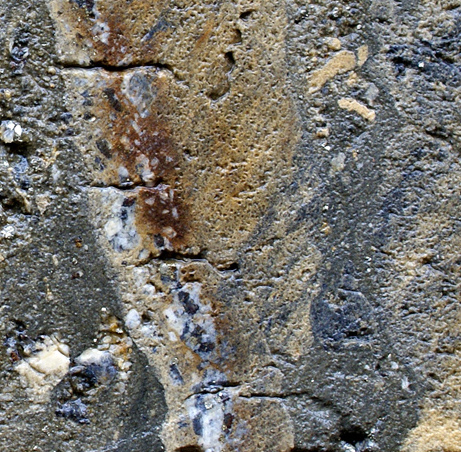| This web page documents brecciation related to hydrothermal deposits in sedimentary rocks surrounding the twin monzonitic body of Fubilan and Sydney at Ok Tedi in Papua New Guinea fold and thrust belt. These styles reflect the hystory of interaction between hydrothermal fluids emanating from these stocks emplaced at shallow crustal-levels into limestone and siltstone layers and tectonics, to form the youngest exposed porphyry Cu-Au deposit. See twin page (Ok Tedi Sulfide Alteration) for description of alteration. |
a) Magnetite breccia in skarn.
Drill hole DDH908 shows the brecciation and substitution of endoskarn by mag-py-cpy.
Figure 1c: In situ, hydraulic brecciation of endoskarn by veins of mag+py+cpy. Note epidotization in endoskarn (sample, 111m DDH908). |
b) Brecciated magnetite skarn
In contrast to the breccia above, DDH894 shows the brecciation of a pre-exisiting magnetite skarn in a silt-sand matrix,
which is possibly contemporaneous with sulfide alteration. A thick body of massive magnetite skarn immediately below this breccia
was not brecciated.
Figure 2a. Limestone clasts in silt-sand matrix (80-81 m, DDH894) below the breccia containing siltstone clasts . |
Figure 2c. Four meters away from Fig. 2a within the same breccia body, angular clasts of magnetite skarn in carbonatic sandy matrix (sample, 77.5 m, DDH894). This breccia lies above a body of well-preserved (not brecciated) finely laminated magnetite (see Fig. 10a) skarn interpreted to represent subsitution of mudstone, that resisted post-skarn brecciation. |
Figure 2d. Angular magnetite skarn blocks in a matrix rich in sulfides (sample, 99.6 m, DDH894). This breccia is below the thick body of finely laminated magnetite skarn and massive magnetite skarn with disseminated sulfides. |
Figure 2e. Magnetite skarn clasts in matrix which contains py+cpy and fibrous actinolite. Fractures filled with py cut across magnetite skarn clasts. |
c) Taranaki Thrust Breccia at Berlin
In the Berlin (W) wall of the mine a thick region of brecciated rocks is known as the Taranaki thrust. This thrust separate normal stratigraphic sequence, with Darai Limestone on top of Ieru Formation. In this region the Ieru Formation is characterized by interlayerd mudstone and siltstone packages.. Mudstone tends to behave viscously forming the matrix of breccias, fault gouge. The limestone clasts dominate on the upper part of the breccia, close to the massive limestone, whereas siltstone clasts dominate in the lower part of the breccia. In this area, steep and sharp faults separate breccias of different natures, indicating considerable movement on these post-breccia steep planes.
Figure 3c. Siltstone breccia in mud matrix. |
Figure 3d. Fault gouge and breccia. |
d) Parrots Beak Thrust Breccia (DDH958)
Figure 4a. Parrots Beak thrust: limestone breccia. |
e) Fubilan Breccia
This breccia occus is a magmatic-hydrothermal breccia inside the Fubilan monzonite porphyry, N contact of the stock.
